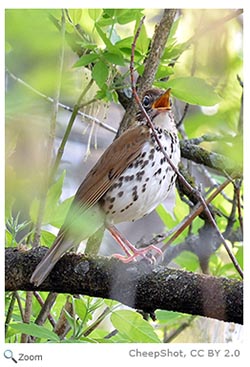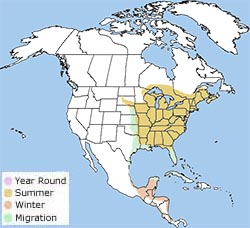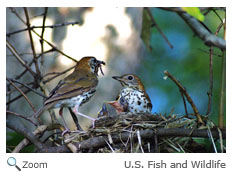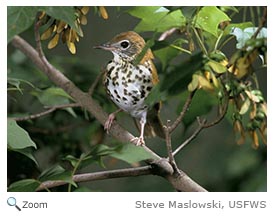Description
 The wood thrush's head, back and wings are brick red in color. It has a white belly speckled with dark spots. Its red coloring helps it stay camouflaged in the leaf litter while it hunts for insects on the forest floor. The male sings a clear, ee-oh-lay that is easily heard throughout its forest home in the spring and early summer. The wood thrush's head, back and wings are brick red in color. It has a white belly speckled with dark spots. Its red coloring helps it stay camouflaged in the leaf litter while it hunts for insects on the forest floor. The male sings a clear, ee-oh-lay that is easily heard throughout its forest home in the spring and early summer.
Range
 A migratory bird, the wood thrush travels from the eastern United States to Central America each year. In the summer, the wood thrush breeds in the eastern half of the United States from southeastern Canada down through Northern Florida. It spends winters in the lowland tropical forests of Central America. A migratory bird, the wood thrush travels from the eastern United States to Central America each year. In the summer, the wood thrush breeds in the eastern half of the United States from southeastern Canada down through Northern Florida. It spends winters in the lowland tropical forests of Central America.
Habitat
 The wood thrush lives in deciduous and mixed forests. It prefers a habitat where there is a mix of large trees, younger trees to make up the understory, shade, and abundant leaf litter on the ground. The wood thrush lives in deciduous and mixed forests. It prefers a habitat where there is a mix of large trees, younger trees to make up the understory, shade, and abundant leaf litter on the ground.
|
|
Diet
The wood thrush is an omnivore, eating both insects and fruit. During the breeding season, it feeds on insects that live in leaf litter on the ground such as spiders, beetles, flies, woodlice and ants. In preparation for migration, the wood thrush feeds on fruit such as blueberry, holly, elderberry, Virginia creeper, pokeweed and dogwood.
Life Cycle
 The female builds a nest in the lower branches of a small tree or shrub. She forms the nest out of grass, leaves and stems, weaving the walls until they are 2-6 inches high and 4-6 inches across. She then lines the inside of the nest with mud and covers the bottom with fine roots. She lays 3-4 turquoise eggs. The eggs are incubated for 12-15 days. Upon hatching, the chicks stay in the nest for another two weeks. The female builds a nest in the lower branches of a small tree or shrub. She forms the nest out of grass, leaves and stems, weaving the walls until they are 2-6 inches high and 4-6 inches across. She then lines the inside of the nest with mud and covers the bottom with fine roots. She lays 3-4 turquoise eggs. The eggs are incubated for 12-15 days. Upon hatching, the chicks stay in the nest for another two weeks.
The wood thrush usually lays 3-4 eggs two times each summer. She makes a new nest for each brood.
Behavior
 Although the wood thrush is still common throughout our forests, its population is declining. Scientists believe that one reason is the cowbird. Adult cowbirds often lay eggs in a wood thrush's nest. The young cowbird is larger than a wood thrush chick and demands more space and food. In some habitats, scientists have found at least one cowbird egg in nearly every wood thrush nest. Although the wood thrush is still common throughout our forests, its population is declining. Scientists believe that one reason is the cowbird. Adult cowbirds often lay eggs in a wood thrush's nest. The young cowbird is larger than a wood thrush chick and demands more space and food. In some habitats, scientists have found at least one cowbird egg in nearly every wood thrush nest. |


 A
A 

